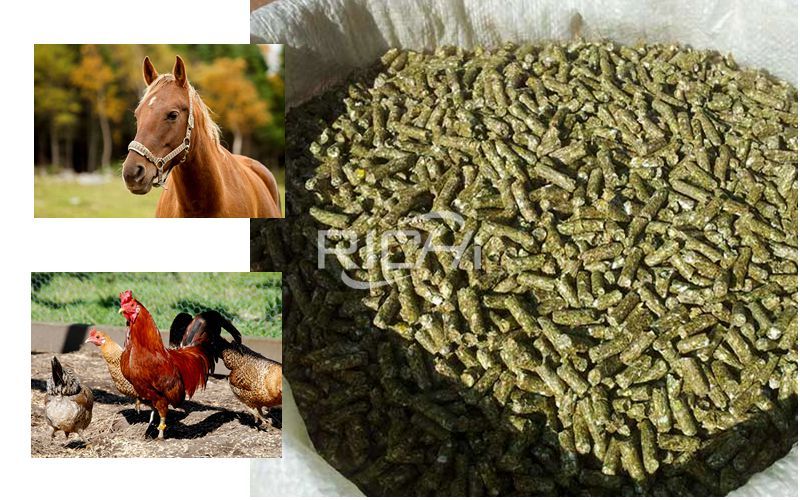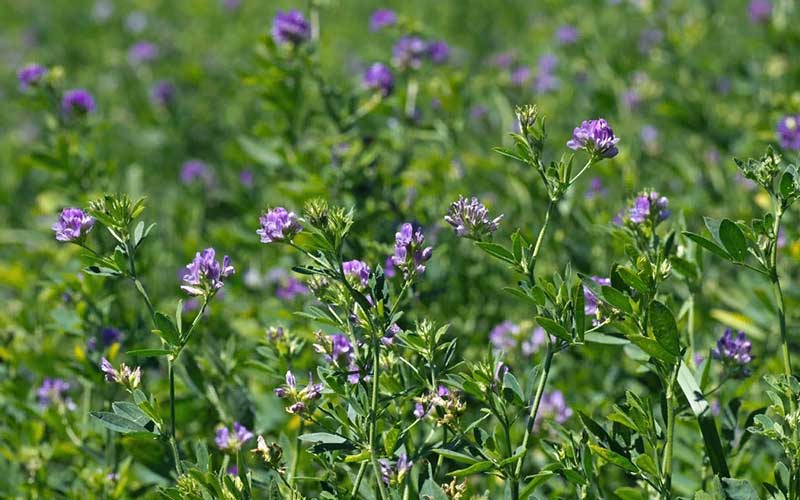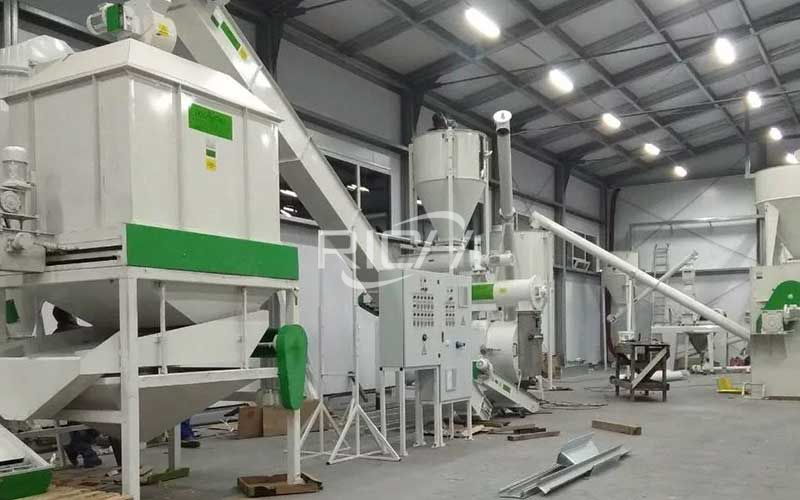
This is where you find all our press releases and news articles.
The Cozad dehydrating plant owned by Matt Burkholder produces 13,000 tons of alfalfa pellets annually from locally grown crops. The pellets — about 1 inch long and a ¼ inch in diameter — are feed primarily for horses, laying hens, and companion animals such as rabbits and guinea pigs.
“Most of our customers are other feed manufacturers,” Burkholder said. “The lion’s share of it is horse. The second is laying hens.” Purina was the plant’s biggest customer last year, he added. Dehydrating, grinding and pelleting alfalfa makes a higher-quality feed that is more easily stored. Burkholder said the market is growing on the organic side.

Can Horse Chicken Eat Alfalfa Pellets
Meanwhile, a growing demand for chicken feed the last four to five years mimics how things were done in the past. Burkholder said his dad, Dave, talks about how alfalfa was fed to nearly every chicken in the late 1970s and early 1980s, before the trend turned to analyzing the vitamins found in alfalfa feed and replicating them.
“As people have gotten more interested in natural and organic, producers have gotten back into feeding the alfalfa instead of the synthetic vitamins,” Burkholder said. “We always claimed there were unidentifiable growth factors in the alfalfa. Animals just seemed to do well.”
There are fewer dehydrating plants in and around Cozad, once known as the alfalfa capital of the world, but the soil and proximity to the Ogallala Aquifer still provide ideal alfalfa growing conditions.

Burkholder farms 3,500 acres, from Lexington to Willow Island and north and south of Cozad, that yield 13,000 tons of pellets and another 1,000 tons of baled alfalfa hay consumed at Will Feed Inc. feedlot where his wife, Anne, is owner-operator.
Burkholder explained that alfalfa is a water-intensive perennial crop that thrives where the water table is high. “We don’t have to pump water or run a sprinkler,” he said, because area irrigation projects seep enough water to support sub-irrigation. “It’s why we’re here. It is a special reason to be here,” Burkholder said. “It’s only true from the Dawson County line to the west and Elm Creek to the east.”
“We’re about the last man standing,” Burkholder said about the decline of alfalfa dehydrating plants. “There are three in Dawson County and three in eastern Nebraska when there used to be 10 times that much.”
There also is an Alfagreen Supreme sign along Highway 30 at Odessa. Burkholder and some partners bought that plant as a site to process and package pellets. The two employees there also grind alfalfa pellets into meal for some customers and package it in quantities of 50 pounds or 1,000 pounds.
“The last couple of years have been as good to us and everybody else,” Burkholder said. “I think we will weather this downturn better when we don’t have the fertilizer and water costs every year. I’ve got good partners and good people to work with. It’s worked well.”
His dehydrated alfalfa product is marketed through Alfagreen Supreme, which was started in Ohio about 55 years ago. The company, which also has six plants in Ohio, and one each in Pennsylvania and Florida, handles sales, billing and collections.
“It would be pretty tough to be out here all by myself,” Burkholder said.
The Cozad plant, which still has a link to its past with Island Dehy Co. signage, has been with Alfagreen Supreme for about five years. Burkholder said pellets previously were marketed through Consolidated Blenders in Hastings.
Burkholder said his grandfather, Ervin “Burky” Burkholder, moved from Ohio to Cozad in 1945 and initially farmed for someone else.
Then on his own, he grew alfalfa and was involved in constructing several alfalfa dehydration plants. After Burkholder’s dad joined the family business in 1969, they bought Mill Island Dehydrators originally at Willow Island and, in 1972, National Alfalfa plant at the current Cozad location.
Burkholder hadn’t intended to be a third-generation alfalfa grower-processor. He left Cozad to study engineering at Dartmouth College in New Hampshire, where he also played football.
In his senior year, he met Anne, a Florida native, and they decided they wanted a rural lifestyle for their future family.
Burkholder worked for his dad for three years, before buying the Cozad plant, which he has operated for the past 15 years.
“In a lot of ways, that’s a giant erector set, just more expensive,” Burkholder said, admitting that it is an outlet for his engineering side to “figure something out and see if we can make this work.” The process to dehydrate alfalfa changed while he was growing up.

Alfalfa feed pellet production line
Originally, direct-cut alfalfa, with 70 percent to 80 percent moisture, was hauled to the plant for drying. Then it was learned that letting windrowed hay stay in the field and dry in the sun before chopping saved on gas costs. “It’s reduced the energy costs significantly and it reduces transportation costs,” Burkholder said.
Using high-moisture alfalfa requires 5 pounds to make 1 pound of the pellet product. However, if alfalfa is at 50 percent moisture when hauled to the plant, it takes 2 pounds for 1 pound of product. “It saves all the way around,” Burkholder said. At the plant, alfalfa is thoroughly dried to 7 percent to 8 percent moisture in a dryer with a big rotary drum that works something like a clothes dryer.
There are 13 employees at the Cozad plant: an office manager, eight others who work year-round and four who work in the summers. Winter work has included shipping much of the inventory from last summer’s stored crop, rebuilding plant equipment and doing preventive maintenance such as changing bearings.
Having the right mix of reliable, high-quality pellet machine and pelletizing systems and expert support is essential to your success. Watch how our end-to-end feed pellet plant solutions have helped our customers optimize their performance.
Our customized and future-proofed turnkey pellet plant solutions is designed with you at the core. From vision to reality and beyond, our team stays connected with yours. Giving you peace-of-mind with an expert at your side.

At RICHI, we go beyond project completion. With RICHI Servicee, we’re your dedicated partners in success. Count on us for expert guidance, minimal downtime, and optimized productivity. Choose RICHI for unmatched service and support.



Meet global product demands and quality standards with industry-leading pellet plant design, engineering, equipment, and construction services for pellet processors.


Your Partner Beyond Project Completion
2000+ cases
RICHI is the leading designer, manufacturer and builder of pellet plants in the world, completing over 2000 projects in 140 countries across 6 continents.
Read More
Increase plant productivity, profitability, and safety by integrating high quality equipment into your pellet production line. Over the years, RICHI has become China's top pellet equipment manufacturer. At the same time, RICHI has established valuable partnerships with the world's leading component and raw material manufacturers to bring you the best there is in technology, automation, and efficiency in pelleting plant machinery.

For nearly 30 years, RICHI has been providing best-in-class pellet plant equipment and services to clients across a variety of industries, sizes, and needs. We pride ourselves on the knowledge and skill that each team member possesses – from our technical sales team to our process design engineers. You can count on RICHI Machinery to take your operation to the next level of innovation, quality, and success.
Need help with your pellet manufacturing plant project? Contact us today.
ANIMAL FEED
BIOMASS
WOOD
ORGANIC FERTILIZER
AQUA FEED
CAT LITTER
MUNICIPAL WASTE RECYCLING
SPECIAL PELLET PRODUCTION
RICHI Machinery continues to deliver world class pellet mill equipment, pellet plant engineering and project solutions that add value to our customers in the animal feed, wood waste, agriculture waste, organic fertilizer, cat litter and special pellet products industries. Throughout the years, we RICHI Machinery have built strong brand, becoming industry-leading pellet machine manufacturer. We value integrity, promise quality, and prioritize your success.
Learn MoreWith our expert team, we precisely implement your process engineering requirements in pellet mill and pelletizing plant systems. No matter which industry you’re in – we understand your needs and deliver solutions that meet the highest standards.
At RICHI, quality comes first. Our pellet making machine and related pellet line equipment undergo rigorous quality controls to ensure they meet the highest standards. Rely on products that are durable, safe, and efficient.
With decades of experience in pellet machine and pellet production line production, we have earned a reputation as a trusted partner in various industries. Our expertise allows us to cover a wide range of applications.
Not only do we offer premium pelleting equipment, but we are also experts at designing, building, installing, and maintaining facilities from the ground up. Our expertise is within pellt plant process design, discovering the most efficient, productive, and profitable way to handle your materials in an end-to-end cycle.
○ RICHI MACHINERY
Keeping in touch with us is an effective way to solve all your problems. If you have any needs or questions, please leave your contact information, then RICHI technical consultants will send design, quotation, videos to your mailbox. You can also contact us directly via WhatsApp: +86 13838389622
Copyright©2015-2026 by HENAN RICHI MACHINERY CO., LTD. All rights reserved.